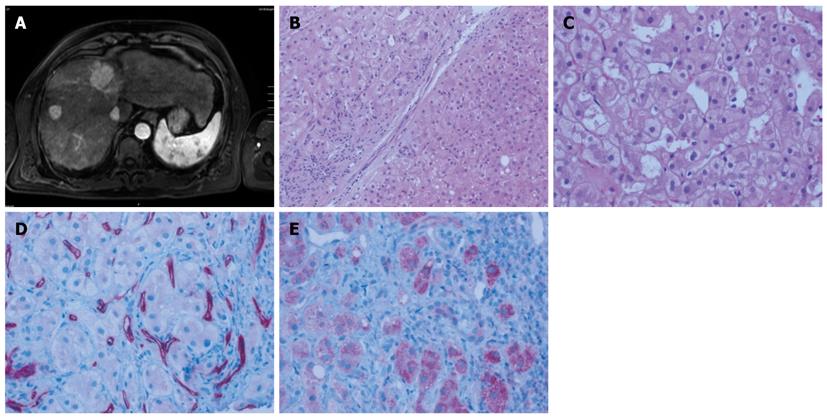Copyright
©2010 Baishideng.
World J Gastroenterol. Jul 28, 2010; 16(28): 3592-3596
Published online Jul 28, 2010. doi: 10.3748/wjg.v16.i28.3592
Published online Jul 28, 2010. doi: 10.3748/wjg.v16.i28.3592
Figure 1 Baseline radiologic and pathologic assessment of the patient in late 2006 before initiation of therapy.
A: Initial magnetic resonance imaging (MRI) scan revealing multiple hepatocellular carcinoma (HCC) nodules; B: Regenerative nodule (lower right) juxtaposed to well circumscribed HCC (upper left) separated by a fibrous septum with a sparse lymphocytic infiltrate (magnification, × 100); C: Representative high power magnification of the HCC showed large tumor cells with occasional vacuoles and microvesicular fatty degeneration of hepatocytes (magnification, × 200); D: Abnormally increased microvessel density within the HCC as demonstrated by CD34 immunohistochemistry (magnification, × 200); E: Tumor cells express VEGFR1 at the tumor front (right) contrasting with weak expression towards to the tumor centre (left; magnification, × 200).
- Citation: Wich C, Agaimy A, Strobel D, Wissniowski TT, Hartmann A, Ocker M. Sustained treatment response of metastatic hepatocellular carcinoma with bevacizumab and sorafenib. World J Gastroenterol 2010; 16(28): 3592-3596
- URL: https://www.wjgnet.com/1007-9327/full/v16/i28/3592.htm
- DOI: https://dx.doi.org/10.3748/wjg.v16.i28.3592









